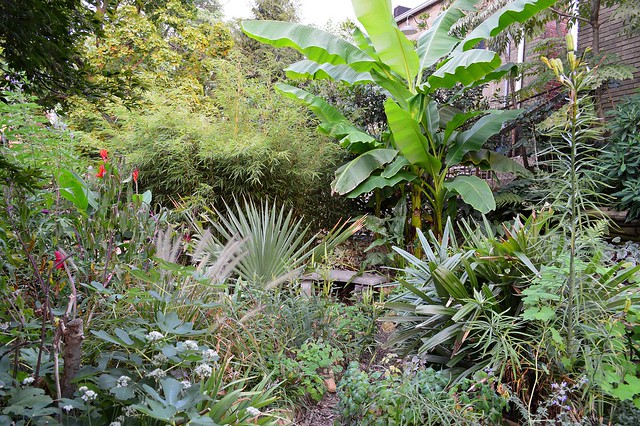
If you're going to "test the limits" you have to be willing to take a few losses. That was the point of my previous blog post (see Testing the limits... and finding them: 2014-2015 losers) when I wrote about the plants I lost last winter, which along with 2013-2014 brought my area's two coldest winters in 20 years. Each of those two winters, on its own, wasn't so unusual; we get winters like that every 10-15 years and we were several years overdue. What was unusual was getting two such winters back to back. That makes the survivors all the more special to me. They don't necessarily look their best this year, but considering the minimal protection I gave them I'm more than happy.
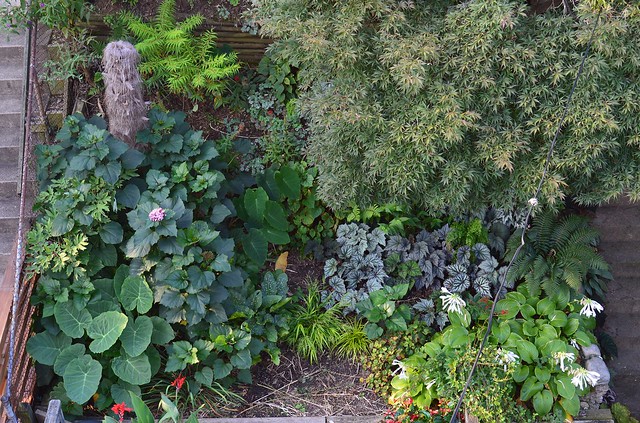
View from the roof: a mix of survivors and new plantings (and a windmill palm corpse)
From 1994 to 2014, the east coast had a series of warmer-than-average winters that fooled a lot of people into thinking that many plants, including (relatively) hardy palms like Trachycarpus fortunei, are hardier than they really are. In January 2014 we were finally reminded what a real winter is like. Even so, that winter and the next—with lows in my back yard of 5 degrees (-15° C)—weren't nearly as cold as February 1994, when Washington, DC had a low of -3 degrees (-19° C). It's just a matter of time before we get another winter like that one, and that will be the next test for some of these survivors. Even plants that I expected to be completely hardy, like Fatsia japonica, Edgeworthia chrysantha, Musa basjoo and Zantedeschia 'White Giant', were set back considerably and might be taken out by a winter like 1993-1994.
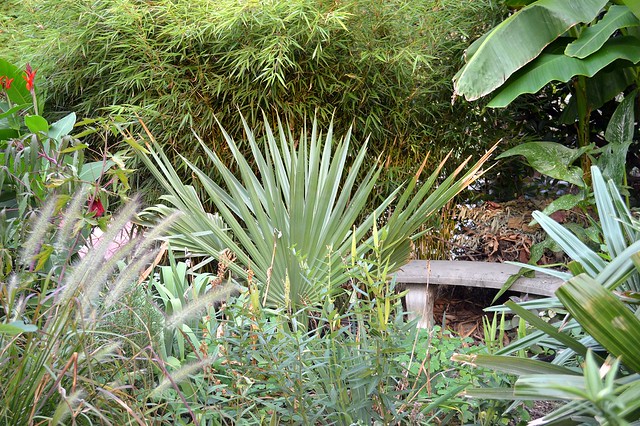
Sabal minor 'McCurtain'
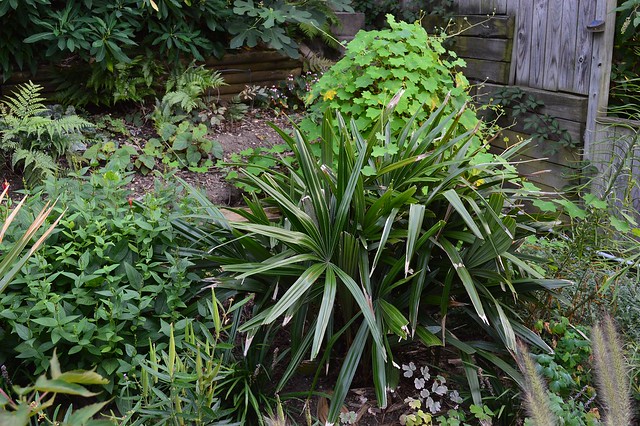
Rhapidophyllum hystrix
I may have lost all my windmill palms, but there are two palm species, both natives of the southeastern USA, that are reliably hardy here: Sabal minor (dwarf palmetto) and Rhapidophyllum hystrix (needle palm). These species showed absolutely no cold damage in my garden during either winter. Sabal minor did suffer some mechanical (folding and crushing) damage from wind, ice and snow; the "McCurtain" strain I'm growing, from a northern population in McCurtain County, Oklahoma, is painfully slow-growing so it's just now starting to look nice again. The needle palm also suffered some mechanical damage, but far less than S. minor. There are several established needle palms in the DC area, with the largest and oldest at the U.S. National Arboretum. That specimen was planted in the 1970's and has never been protected, although a former arboreum staff member told me it was killed to the ground during an exceptionally cold winter in the 1980's.
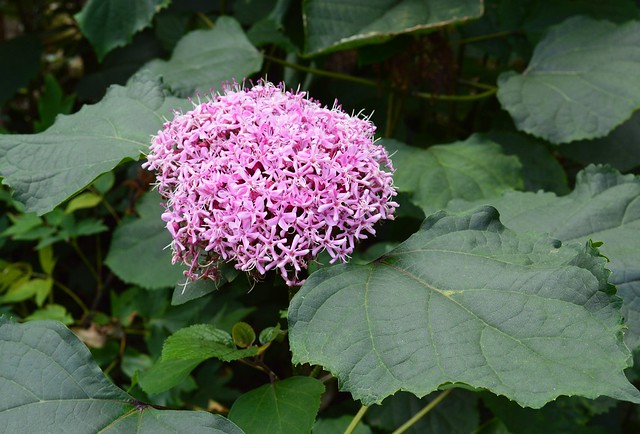
Clerodendrum bungei, a beautiful monster
Two fairly unsurprising winners have been my "beautiful monsters", Clerodendrum bungei and Tetrapanax papyrifer 'Steroidal Giant'. Both are fast-growing plants that spread aggressively from deep root suckers, so even if they freeze to the ground they'll usually come back and make a good show. This was the case with C. bungei, which bounced back and bloomed as if nothing had happened and continues to pop up all over my garden; I tolerate it for the bold foliage, long blooming season, and fragrant flowers that are attractive to butterflies. What surprised me was that T. papyrifer 'Steroidal Giant' survived in a pot with no protection; another in the ground even had two or three feet of trunk survive. This recently introduced selection seems to be hardier than the older and smaller clone of the species, which always died to the ground in my garden even during fairly warm winters.
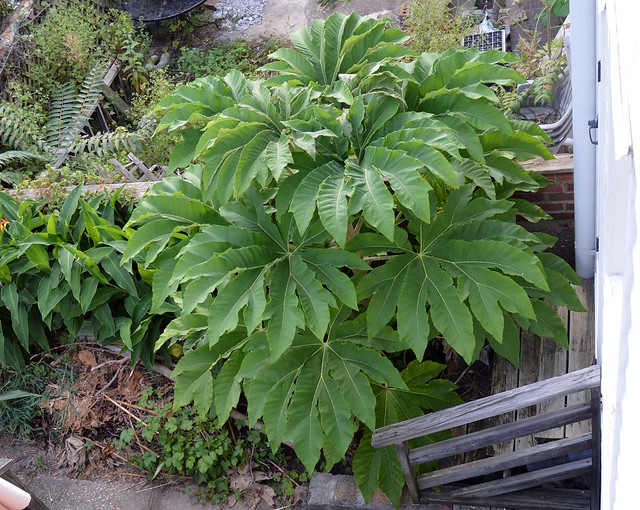
Tetrapanax papyrifer 'Steroidal Giant': 8 feet tall and still growing
A beautiful monster that probably would have survived, had I allowed it, is Passiflora caerulea. This was killed to the ground in 2014, permanently I thought, but then it came up from root suckers all over my garden. After several years of fighting it, I concluded it was too aggressive for my small garden and ruthlessly pulled out every sucker as it showed up. No sign of it this year, so I guess it finally got the message.
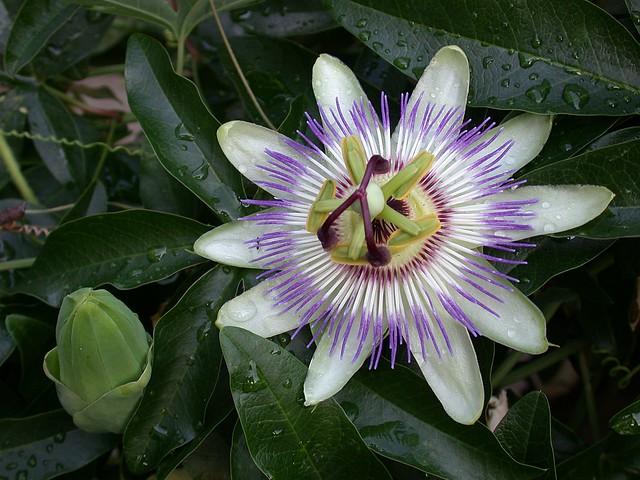
Passiflora caerulea (2010)
Another surprise potted survivor was my 'Brunswick' fig. My figs died mostly or entirely to the ground the last two winters, but this potted plant on my roof deck didn't. It was against the house and out of the wind, but I'm still surprised it had virtually no damage, especially when the potted Ginkgo biloba right next to it ended up dying. It's even producing figs! I grow this fig mostly for the foliage, which is very deeply lobed and more ornamental than most. The figs themselves are good, but have an open "eye" and tend to be full of ants and spoil easily.

Ficus carica 'Brunswick' (a.k.a. 'Magnolia')
My 'Brown Turkey' fig died to the ground both of the past two winters; it's suckering vigorously from the base and the new wood is producing a few late figs, but most won't ripen before frost comes in November. I may get a few ripe figs from an unknown cultivar that I call "Christian's prolific"; I got this one several years ago from my friend Christian Feuillet in Beltsville, Maryland (an outer suburb of Washington, DC) who found it already growing at his house when he purchased it over 25 years ago. This one didn't die all the way to the ground, and the new growth has quite a few figs coming. It has proven to be a hardy and dependable plant with two heavy crops of excellent figs per year, assuming I can beat the birds and the squirrels to them! The figs have a closed "eye" and are more resistant to bugs and spoilage.
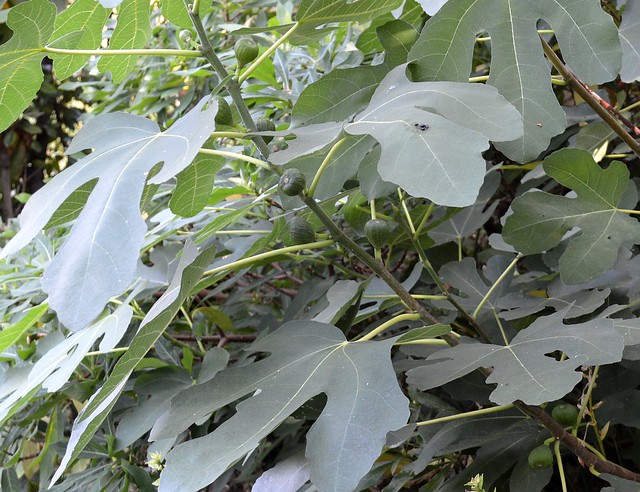
Ficus carica "Christian's prolific"
Probably the biggest surprise this year was Colocasia gigantea. I was given this plant by my friend Steve Silberstein several years ago, and the plants grew quite large during their first year and survived their first winter. That was a warm winter, and it came back a bit less strongly and didn't grow as large. I was certain the first cold winter had killed it but last year I found a few small, weak plants in late summer, struggling under Clerodendrum bungei. I didn't think them worth coddling and forgot about them, certain they wouldn't make it through another winter. They proved me wrong and came back this summer, again rather late and rather weakly, but now that I've cut back C. bungei they're making up for lost time.
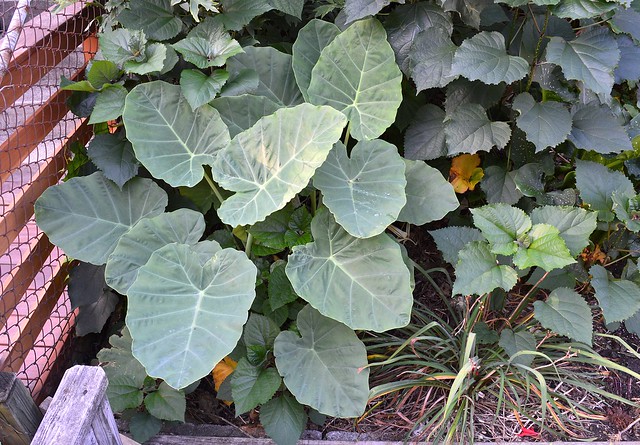
Colocasia gigantea, August 2015
Less surprising is Colocasia esculenta 'Pink China', a Brian Williams (Brian's Botanicals) introduction that is living up to its reputation for hardiness. This one has been in my garden for about 6 years and while the survivors that come up every spring are generally rather small, they grow very rapidly. The biggest problem I've had, as with all cultivars of C. esculenta, is that they demand more water than I can give them and nearly always end up with crispy edges. Colocasia gigantea, along with various Alocasia and Xanthosoma species, are much more tolerant of dry soil and their foliage holds up better under my conditions.
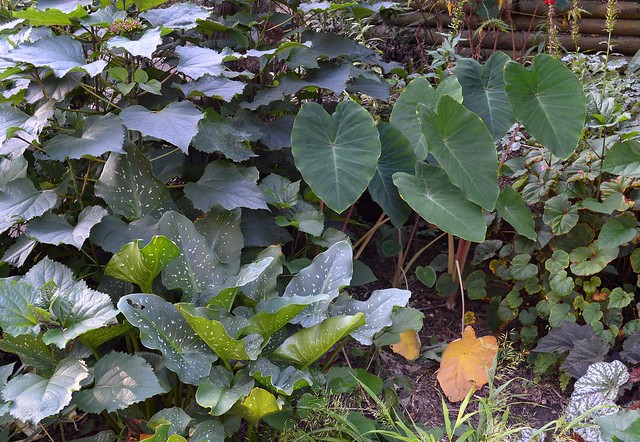
Colocasia esculenta 'Pink China'
Among the ferns, Coniogramme japonica, "bamboo fern", rated by Plant Delights Nursery as hardy to zone 7b "at least", has been in my garden for several years. It had no trouble with the first cold winter; I thought the second had finally done it in, but it emerged in early summer. As much as I want to love this plant, I find its growth habit unkempt and messy and it has never been beautiful in my garden.
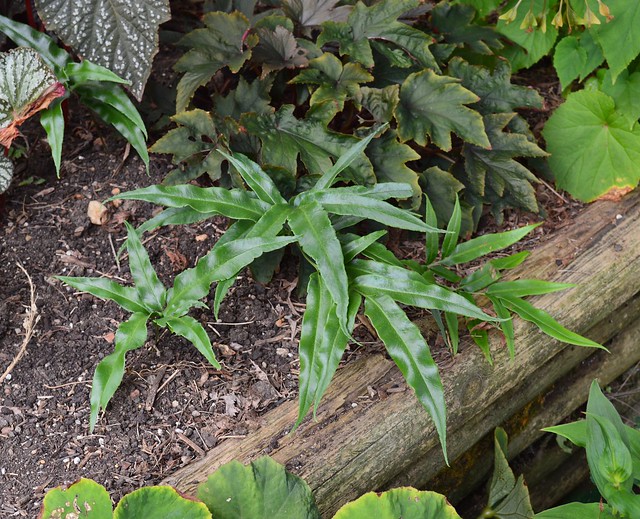
Coniogramme japonica
Another fern that survived is Pteris wallichiana 'Hualien Giant', another 2014 Plant Delights Nursery purchase. The catalog rates this big, tropical-looking fern as hardy to zone 7b "at least" and while it was technically a winner in terms of winter survival, and tried valiantly to grow this spring, slugs mowed down all but one of the emerging fronds (and that one frond is looking pretty sad). In its weakened state, I'll be surprised if it survives another winter, cold or otherwise.

Pteris wallichiana, slug bait
I was pleased to see my "mystery maidenhair" return. I've had a couple of fern experts examine it and they aren't quite sure what it is. The best identification we can put on this plant is Adiantum raddianum, which is exactly what one would expect in the houseplant section of a garden center where I found it. The problem is that it's proving much hardier than A. raddianum is supposed to be. Maybe I've stumbled upon a hardy strain of the species? I've found that its bright green fronds provide an effective contrast to the darker-leafed begonias in my garden.
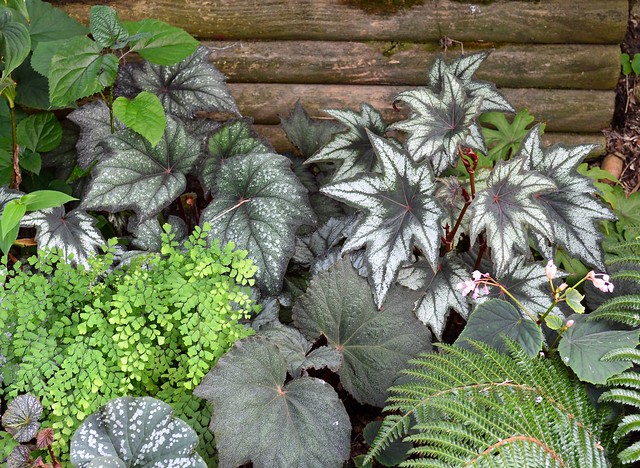
Adiantum sp. "mystery maidenhair" (left), Begonia 'Little Brother Montgomery' (right)
Ah yes, the begonias. In my last post I noted that I was shocked to lose nearly all my begonias that had survived the previous winter. I'm happy to report there have been some survivors! After 5 years in my garden I thought I had finally lost 'Little Brother Montgomery' but very late in the spring first one, then another, and then another came up. Although a couple of them came up rather weakly, I don't think I lost any. Good establishment may have made a difference here, but this does indeed seem to be a hardy cultivar. This is a potentially large-growing plant but it will never reach its full size where it dies back in the winter. In my opinion, the foliage is ornamental enough to make up for it, especially when several are planted together.
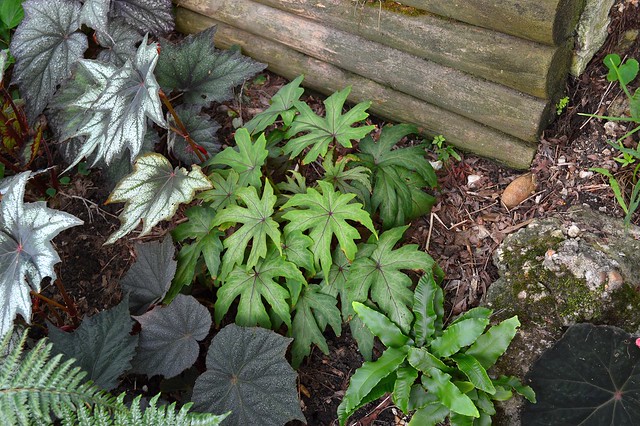
Begonia pedatifida
Not unexpectedly, the "hardy begonia" Begonia grandis and its various variants all came through. But I was pleased to see several others return: B. emeiensis, B. pedatifida, and U584. All of these have creeping rhizomes at the soil surface, so they clearly have some resistance to freezing. B. emeiensis has been problematic only because it requires constant moisture, and tends to look stressed and crispy by the end of the summer. For more information on these and other hardy species, see Beyond Begonia grandis: new hardy begonias.
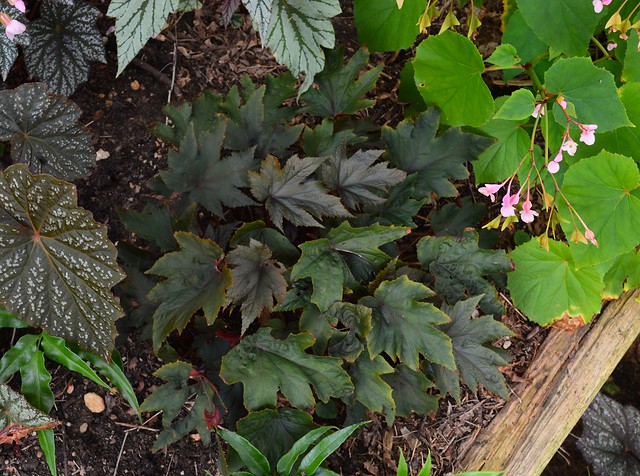
Begonia U584
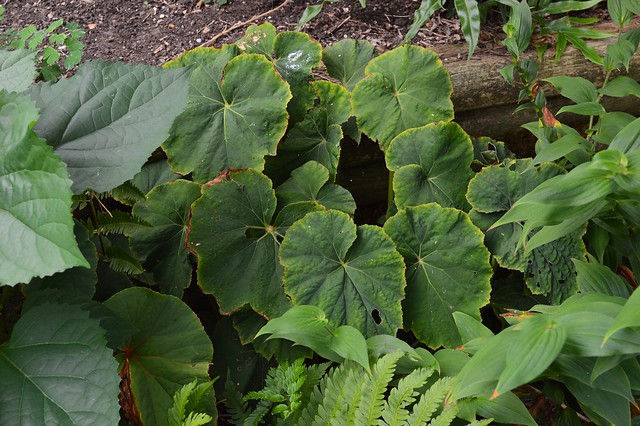
Begonia emeiensis
Another survivor was 'Torsa', a B. grandis hybrid. It's very similar to that species (and seems to be almost as hardy) but is has much large leaves. This one has been around for several years and I'm surprised nobody else seems to be growing it in zone 7.
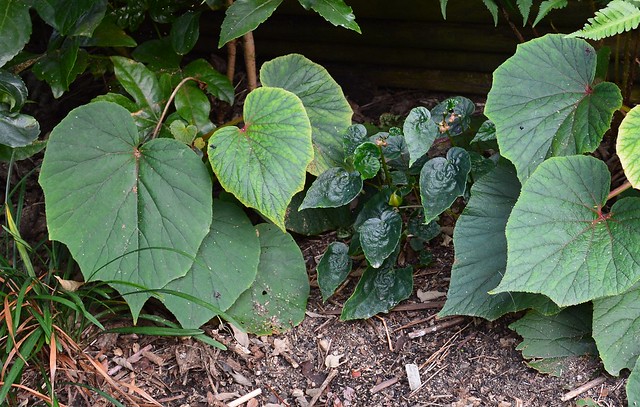
Begonia 'Torsa' with unidentified species from Taiwan
And yes, I had a few of my own hybrids survive. I'm not sure any of these are either distinctive or vigorous enough to name as cultivars, but the fact that they survived such a cold winter with minimal protection—a winter that killed most other begonias—shows me that I'm heading in the right direction with my attempts to breed hardy begonias.
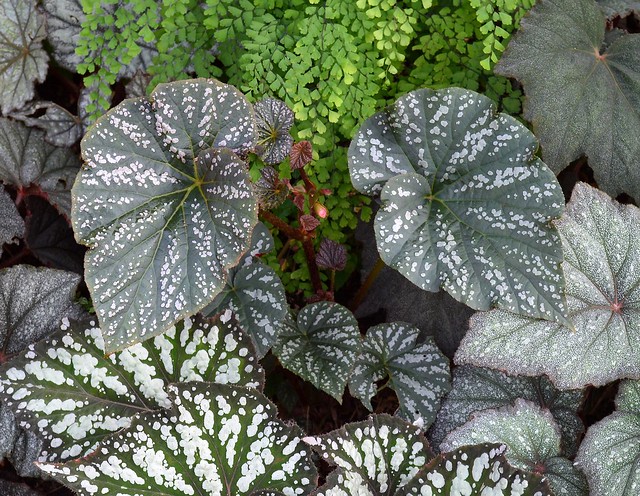
Begonia, unnamed hybrid (survived 3 winters)

Begonia, unnamed hybrid
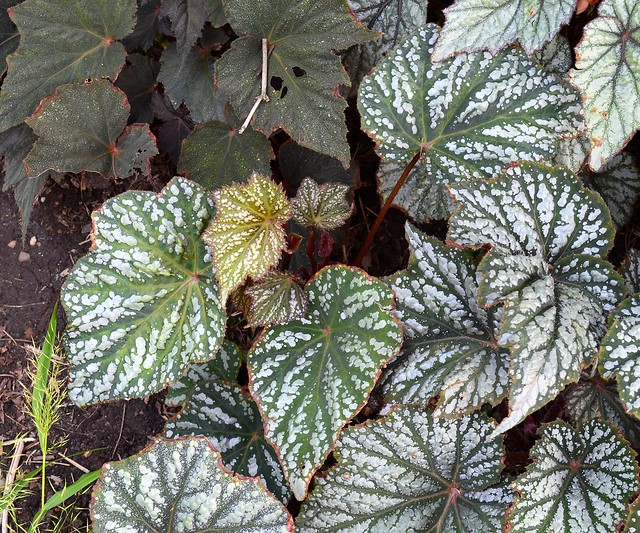
Begonia, unnamed hybrid
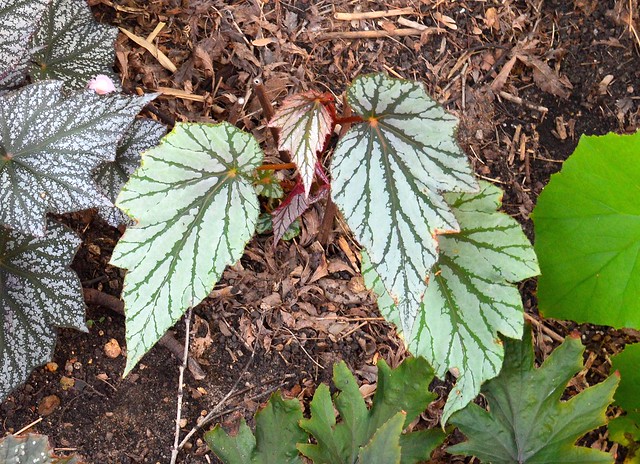
Begonia, unnamed hybrid
Despite the losses, I've had a lot of fun experimenting with plants, with the satisfaction of success more than outweighing the discouragement and learning a lot along the way. What will next year bring? I'm growing out a lot of new begonia hybrids from my own crosses and who knows, maybe next year I'll be reporting on some fabulous new hardy begonias.
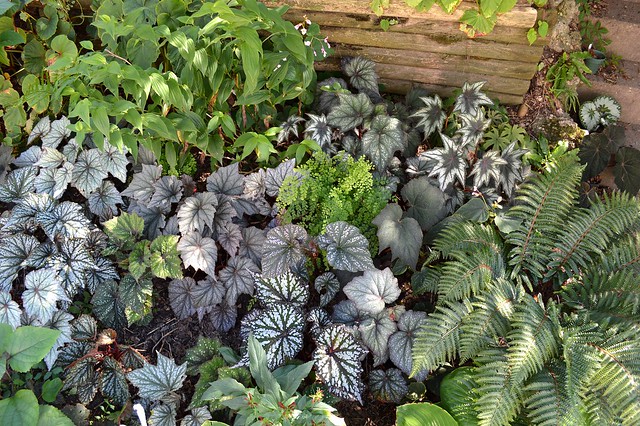
Begonias, new hybrids and a few survivors

I wonder if Clerodendrum bungei would make it here in the Boston area... Clerodendrum trichotomum appears to do quite well here. Surprised the figs sustained such heavy damage, but not at all surprised with the needle palm. A small specimen has survived the last two very harsh winters at my parents' place in Michigan (!) with only light damage with just a rose cone and some leaf mulch.
ReplyDeleteYour images of mass plantings of the Begonias are always inspiring.And wow, I am amazed at your Tetrapanax success!
ReplyDeleteVery impressive! I wonder if you're in a warmer microclimate with all that concrete around you. I love your begonias. :o)
ReplyDeleteCape may city,Cape May ,NJ has a surviving Windmill Palm. Its in a huge ceramic pot on along the main road into town from the Garden State Parkway.
ReplyDeleteso I guess it gets winterized for protection.
Of great disappointment was the death of a once thriving windmill palm on Farragut st Wildwood Crest,NJ. I assume a new homeowner with no concept of palm care?. It had been protected for years.